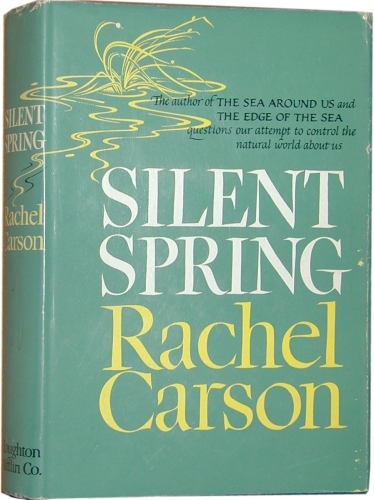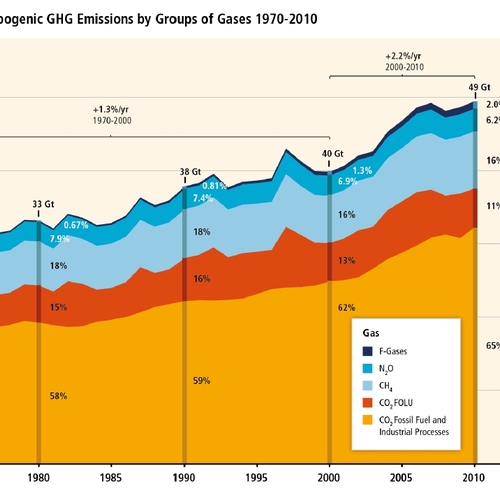With Earth Day this past Sunday, I’m inspired to reflect on what motivated me — some 45 years ago(!) — to focus on a career of environmental protection and improvement, a career that has led me to a significant focus on more sustainable energy solutions. Back in the late 1960s at age 12 or 13, I became immersed in “conservation” and decided that this would be my life career. This was before the modern “environmental” movement really began, and “conservation” was the term used to describe environmental protection.
Rachel Carson’s book Silent Spring had come out in 1962 (50 years ago this year) and awakened the public to environmental concerns with pesticides like DDT; I consider Carson to have really ushered in the modern environmental movement. I read the book in my early teens and became a activist fighting for the banning of persistent chlorinated pesticides.
The first Earth Day
Those were the activist days of the ’60s, and I became the Earth Day organizer in my junior high school in Wayne, Pennsylvania. I remember putting up mimeographed flyers (yeah, there was paper waste!) in the hallways of our school promoting the huge Earth Day celebration that was to happen in Fairmount Park in Philadelphia, then spending the day there absorbing the energy and listening to the speakers. That was in 1970. A lot has happened since.
In high school and college I assumed that a career dedicated to protecting the environment meant studying biology and ecology, and I imagined myself becoming an aquatic biologist or field ecologist, spending my days outside researching ecological succession or how to deduce water quality from the algae species found growing lakes and rivers.
Indeed, in a biology class in high school, I spent half the year on an independent-study project investigating how an aquarium full of pond water changed in chemical and biological composition over a several-month period as algae blooms occurred and the populations of some aquatic organisms soared and then collapsed. In that aquarium, I had created an ecosystem in which some organisms were altering their environment in ways that fundamentally changed their living conditions; some species disappeared entirely.
That microcosm of the far-more-complex ecosystems of Earth left deep impressions on me — and helped to fuel my lifelong interest in the environment.
A shift to renewable energy
Throughout my environmental activist days in high school and college I was engaged in fighting air-pollution-spewing power plants, pushing for bans of toxic chemicals, and pushing back against all sorts of development. In short, I was against stuff.
But then in the summer after my junior year of college, I got involved in a joint project of Ithaca College and Cornell University, examining energy self-sufficiency. Our group of idealistic students had secured a National Science Foundation grant to spend a summer studying whether a farm in Danby, New York could achieve energy self-sufficiency.
While my original focus on that project was to study the forest ecosystem and determine what a sustainable biomass yield would be, I got very involved in studying solar and wind resources and helping build various home-grown systems to harness those renewable resources. This was really at the dawn of the solar age, and it was very exciting to be building solar greenhouses, simple batch solar water heaters, Savonious-rotor wind turbines made out of 55-gallon drums, and other odd-ball contraptions designed to reduce our use of fossil fuels.
I don’t think we achieved energy self-sufficiency on that farm — but we were all inspired by the opportunities afforded by renewable energy. Promoting solar energy, windpower, small-scale hydropower, and sustainable biomass combustion was a way to be for something instead of against things.
Promoting passive solar solutions in New Mexico
After college I acted on that interest by applying for and getting a job in Santa Fe working for the New Mexico Solar Energy Association, which was at the forefront of the passive solar energy movement. I was initially a Vista Volunteer, then leader of the NMSEA Workshop Crew that traveled around the state leading hands-on construction workshops teaching mostly low-income people about such solar energy systems as attached solar greenhouses and Trombe walls.
Those workshops took me to some incredible places, including Navajo and Apache reservations, the remote Catholic Christ in the Desert Monastery miles down a dirt road with no access to the electric grid, the poor yet picturesque subsistence-farming community of Chama, and the odd-ball town of Truth or Consequences (which really has that name). These workshops also taught me a lot about how to communicate with people as well as how to build.
A move to Vermont
While I had initially thought of my New Mexico work as a sort-of interlude to my pursuit to a career in environmental biology or ecology, somewhere during that period I came to realize that I could probably accomplish more to help the environment by focusing on reducing the environmental impacts of buildings.
In 1980, at the age of just 25 and with almost no background in organizational management, I moved to Brattleboro to take a position as executive director of what was then called the New England Solar Energy Association. NESEA had been founded five or six years earlier as a spin-off of the pioneering Grassybrook Village solar development in Brookline, Vermont, which failed when bank financing was pulled at just the wrong time. The organization is still going strong, but is now located in Greenfield, Massachusetts, and known as the Northeast Sustainable Energy Association.
A month after I arrived in Brattleboro and took the helm at NESEA, Ronald Reagan was elected president. When he took office a few months later, one of his first priorities was to undo the energy conservation and renewable-energy policies of his predecessor, Jimmy Carter. That shift in policy was tragic in terms of our nation’s continuing dependence on fossil fuels, our path toward mushrooming carbon emissions, and our exit from the world leadership role with renewable energy technology. But for NESEA, in an odd way, it turned out to be a good thing.
With Reagan in office, our organization lost its federal support, which had accounted for about half of our budget. We struggled initially and had to tighten our belts, and I was forced to lay off a couple of employees, but the change forced us to diversify as an organization away from just solar energy toward sustainability — thus the name change we made. We started a series of highly successful regional conferences that continue (check out the Building Energy Conference), and NESEA remains one of the nation’s strongest regional energy organizations to this day.
In 1985, after five years, I left NESEA to go out on my own. Next week I’ll cover the next chapter in my career and the formation of BuildingGreen, which is based in Brattleboro and has a staff of 20.
Alex is founder of BuildingGreen, Inc. and executive editor of Environmental Building News. Watch for a forthcoming BuildingGreen special report on windows coming out later this week. To keep up with Alex’s latest articles and musings, you can sign up for his Twitter feed.
Weekly Newsletter
Get building science and energy efficiency advice, plus special offers, in your inbox.













4 Comments
Where in Danby?
I live in Danby and am curious where the farm you worked on was/is? As a community, we're tackling renewable energy issues, looking into biomass and wind power. The Danby Land Bank has the potential of local energy and jobs, if we can get it going: http://www.danbylandbank.com/site/home.html
Danby, NY
Eric,
That's cool! I don't remember the exact location, but the farm was called Blueberry Hill and owned by Mark and Diedre Silverman, professors at Ithaca College. Looking over your website, I see Brian Caldwell involved. He was part of the group way back then; he will know exactly where the farm is.
It sounds like a great initiative you have going! I may be back in touch down-the-road, as there are some things along these lines that we're trying to do in Vermont.
Thanks for the reply, Mark.
Thanks for the reply, Mark. The Silverman's are part of the land bank, maybe the same property. I'll check with Brian, we ride the bus to Cornell most days, and are good friends. If you want to connect with the land bank, send me a note: [email protected]
This web site is great, we built a "green home" and Ithaca has a strong support network of green builders. I really appreciate what you are doing.
Take care,
Eric
Thanks for the background
Alex - I've long admired your work - thanks for giving us the "back story."
Log in or create an account to post a comment.
Sign up Log in